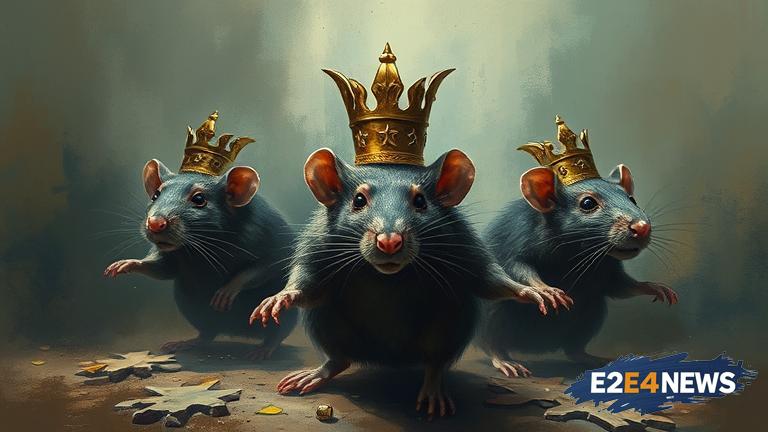Rat kings, a term used to describe a group of rats whose tails have become knotted together, have long been a subject of fascination and debate. While often viewed as a myth or an urban legend, rat kings are, in fact, a real phenomenon that has been observed and documented in various parts of the world. The exact cause of rat kings is still not fully understood, but scientists believe that it may occur when a group of rats are trapped or confined in a small space, causing their tails to become tangled. Another theory suggests that rat kings may form when a group of rats are trying to escape from a predator, and their tails become knotted in the process. Despite the uncertainty surrounding the origins of rat kings, one thing is clear: they are extremely rare, with only a handful of documented cases in history. In fact, the National Geographic reports that there have been only about 60 recorded cases of rat kings worldwide. The majority of these cases have been found in Europe, particularly in Germany and France, where rats are more common. Rat kings can consist of anywhere from a few to over a dozen rats, all tangled together by their tails. In some cases, the rats may even be from different species. The rats in a rat king are often found to be dead, suggesting that the entanglement may be fatal. However, in some cases, the rats have been found alive, although they are usually severely injured. The discovery of rat kings has sparked a range of reactions, from fascination to horror. While some people view rat kings as a curiosity, others see them as a sign of bad luck or even a harbinger of doom. In medieval Europe, rat kings were often seen as a sign of impending disaster, such as a plague or famine. Today, however, rat kings are recognized as a rare and intriguing phenomenon that can provide valuable insights into the behavior and ecology of rats. Scientists are still studying rat kings to learn more about the circumstances that lead to their formation. By examining the bodies of rat kings, researchers can gain a better understanding of the biology and behavior of rats, as well as the ecosystems in which they live. Furthermore, the study of rat kings can also shed light on the evolution of rat behavior and the ways in which they adapt to their environments. In addition to their scientific significance, rat kings have also become a popular topic in folklore and popular culture. They have been featured in numerous stories, legends, and artworks throughout history, often symbolizing chaos, disorder, or the supernatural. The fascination with rat kings is not limited to Europe, as they have also been documented in other parts of the world, including Asia and North America. In some cultures, rat kings are seen as a symbol of good luck or prosperity, rather than bad luck. Overall, the phenomenon of rat kings remains a fascinating and complex topic that continues to capture the imagination of scientists and the general public alike. As researchers continue to study rat kings, we may uncover even more secrets about these mysterious creatures and the world they inhabit. The study of rat kings is a reminder of the importance of continued scientific research and exploration, as well as the need to separate fact from fiction when it comes to unusual and intriguing phenomena. By exploring the science behind rat kings, we can gain a deeper appreciation for the natural world and the many wonders it contains.
